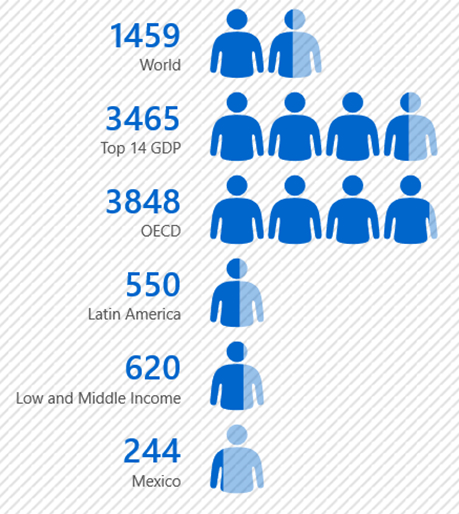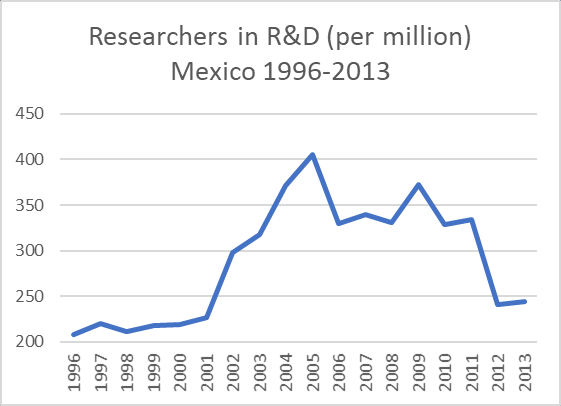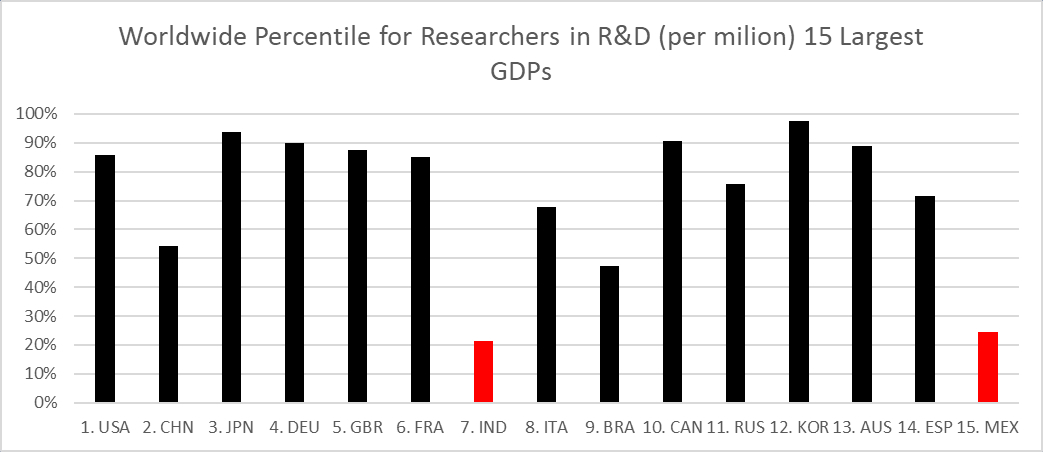Mexico is experiencing a crisis in innovation and technology. The degree, duration, origin, and extent of the crisis will likely cause much debate amongst the learned and august intelligentsia, but it is hard numbers that lead us down the path of this pronouncement, not hyperbole.
Innovation itself has been a frequent topic of discussion in this paper series. [1] [2] [3] [4] [5] [6] [6] [7] [8] [9] [10] [11] [12] [13] These papers have ranged from identifying economic benefits to innovation, shortcoming in parts of Mexico’s innovation landscape, and the University’s role in the national innovation Landscape. And yet, most of these explorations have had to rely on global or national indicators as well as the personal experiences of those involved in the specific articles to draw conclusions and inferences. A recent collaboration between UPAEP and the National Council of Mexico for Graduate Studies (COMEPO) has added a much more local perspective to these discussions and will certainly generate much discussion in this and other forums. [14] Having hard data on the direct region of influence for UPAEP and our day-to-day work and outcomes is a valuable tool that we need to take maximum advantage of in crafting strategy and future work and will be used extensively in this new series of papers covering the innovation crisis.
According to the World Bank, Mexico is currently the world’s 15th largest GDP, placing it well within the top 10% of countries by GDP in 2018 PPP dollars. [15] And yet, in a world that is running at a breakneck speed into the next Industrial Revolution (4th, 5th, or whatever may be currently fashionable) of highly technological and digitalized workspaces Mexico is far from the forefront of research, innovation, and technology.
One indicator which can help diagnose this problem, at least by proxy, is the number of researchers employed in R&D per million in the country. [16] Because not every country reports data every year, the average was taken for reported data over the period 2013-2018. Of the top 15 GDP countries, only 3 are below the 1000 researchers in R&D per million: Brazil (857), Mexico (244), and India (216). The summary of some more of these comparisons can be seen in Figure 1. Even if these data are not always up to date for each country, trends can be seen and discussed.
For clarity, the World Bank indicator defines researchers working in R&D as follows:
“Researchers are professionals who conduct research and improve or develop concepts, theories, models techniques instrumentation, software of operational methods. R&D covers basic research, applied research, and experimental development.” [16]

Figure 1 Number of Researchers in R&D (per million), summary (top to bottom on the graph) for the world, top 14 GDP economies, OECD members, Latin America, Low and Middle Income Countries, and Mexico [16]
In the past few years of reporting these data, Brazil has had a steady increase in these numbers, and India has not reported enough to mark a trend. Of particular concern is that the trendline for Mexico shows an absolute decline that has completely erased any and all gains in the past few years, as seen in Figure 2. [16] The peak year came in 2005, with over 400, and by 2013, the numbers had dropped to 2002 levels.

Figure 2 Year-by-year reported data for the World Bank indicator on Researchers in R&D (per million) for Mexico - years reported are 1996-2013 [16]
When we look at the percentiles (worldwide) for Researchers in R&D (per million), for the world’s leading 15 economies, Mexico and India lie as stark outliers, as seen in Figure 3, hovering in the 20-25th percentile.

Figure 3 Percentile rank worldwide, averaged over reported data 2013-2018. Data shown for top 15 economies by GDP. India and Mexico highlighted for clarity. [16] [15]
At the time this paper’s publication, Mexico is celebrating the 35th year of one of the major public policy factors in this analysis – it’s National Research Fellows System (Sistema Nacional de Investigadores, SNI). [17]. Through an independent consulting division for the government focused on science and technology (Foro Consultivo Científico y Tecnológico, A.C. - FCCyT), we get a “by the numbers” review of this system from its inception in 1984 to 2016, the year the report was published. [18] The report states that in 2016, there were ~25,000 members of this body of the nation’s most renowned researchers. By 2011, these were supposed to be approximately 41% of all academic researchers in Mexico.
These numbers are somewhat misleading, however. It is possible to be listed among the SNI fellows and not be affiliated at least part-time with any institution in Mexico. The only caveat is that these SNI fellows may not receive the fiscal stimulus that is at the core of the fellowship. There are no clear numbers on the percent of SNI fellows are not currently doing active academic work within Mexico or an accredited Mexican institution. Additionally, specific data on how many of these fellows may be in industrial/private sector or independent research positions and not receiving the stimulus was not found. It is highly unlikely that these are a significant percentage, as by its very nature the SNI fellowship is intended to be focused on active academic members affiliated with accredited institutions of higher learning in Mexico.
By 2019, the number of SNI fellows is closer to 30,000 than the FCCyT last reported number of ~25,000, though no definitive data has been published yet. Nevertheless, assuming a best-case scenario where all 30,000 SNI fellows are contributing actively to academic research in Mexico, that would make the total number of academic researchers roughly 67,000 by the last known data published by the FCCyT. [18]
Here, the World Bank statistic is at its most troubling for Mexico – given Mexico’s current population estimates, there are ~30,000 researchers working in R&D in all of Mexico. [16] That statistic makes no distinction between employees of companies an academics. As the definition states: “R&D covers basic research, applied research, and experimental development.”. So, given that there are perhaps 60-70,000 researchers in academic positions nationwide, and no clear data on non-academic R&D workers – the dearth of R&D workers in Mexico is laid out in stark relief. Even if all the R&D workers performing basic research, advanced research, and experimental development were academics, they would constitute less than 45% of the people listed as “academic researchers” at institutions nationwide. And if instead 100% of those researchers were in private-sector/industrial or self-employ, these would still represent an all-too-small portion of the workforce in Mexico.
The data from the recent report on graduate programs in our region will be extremely helpful in sorting out this puzzle. [14] The data within that report adds context and information for understanding how some of these global-scale indicators may be acting on a local level. We must understand this problem to begin piecing together the strategic decisions that will make a difference in meeting the challenges posed by this innovation crisis. UPAEP has the talent, people, and positioning to be a leading institution in facing this national crisis. Doing so is at the core of our mission to be transformative and impact the common good in our region, the nation, and the world.
The rest of this paper series will follow these lines of discussion (with the Spanish version on alternating weeks):
- Further definition, exploration, and demarcation of this crisis
- Filtering the data through the lens of the local educational context as described in the COMEPO report.
- A series of proposals for general, large-scale goals which can serve as north stars for the work to be undertaken
- Specific strategic guides and targets for which the UPAEP can take a leadership role in the region and in Mexico.
Referencias / References
Juan Manuel López Oglesby, "Digitalized Innovation Ecosystem: “iideas”," UPAEP Graduate School, Puebla, Science Strategy Position Paper 2018. [Online]. https://goo.gl/y47hbp
Juan Manuel López Oglesby, "Innovation and Diversity: Tomorrow’s Leader on the World Stage," Graduate School, UPAEP, Puebla, Science Strategy Position Paper 2018. [Online]. https://upress.mx/index.php/
opinion/editoriales/ innovacion-y-tecnologia/3220- innovation-and-diversity- tomorrow-s-leader-on-the- world-stage Juan Manuel López Oglesby, "Leadership in a disruption ecosystem," Graduate School, UPAEP, Puebla, Science Strategy Position Paper 2018. [Online]. https://upress.mx/index.php/
opinion/editoriales/ innovacion-y-tecnologia/3325- leadership-in-a-disruption- ecosystem Juan Manuel López Oglesby, "Research and Innovation Reform as a Transformation Catalyst in Mexico," Graduate School, UPAEP, Puebla, Science Strategy Position Paper 2017. [Online]. https://goo.gl/V2xSqd
Juan Manuel López Oglesby, "Science Whys," Graduate School, UPAEP, Puebla, Science Strategy Position paper 2018. [Online]. https://upress.mx/index.php/
opinion/editoriales/ innovacion-y-tecnologia/2250- science-whys Juan Manuel López Oglesby, "Science, Strategy, and SWOT," UPAEP Graduate School, Puebla, Science Strategy Position Paper 2018. [Online]. https://goo.gl/WrVVNK
Juan Manuel López Oglesby, "Skills, Strategy, and the University," Graduate School, UPAEP, Puebla, Science Strategy Position Paper 2018. [Online]. https://upress.mx/index.php/
opinion/editoriales/ innovacion-y-tecnologia/3026- skills-strategy-and-the- university Juan Manuel López Oglesby, "Some see things that are.," UPAEP Graduate School, Puebla, Science Strategy Position Paper 2017. [Online]. https://goo.gl/wqSfyS
Juan Manuel López Oglesby, "The Economic Impact of Innovation," UPAEP Graduate School, Puebla, Science Strategy Position Paper 2017. [Online]. https://goo.gl/KNcFih
[10]
Alfred Max Hofbauer Balmori and Juan Manuel Lopez Oglesby, "A Primer on Innovation," CESAT and Graduate School, UPAEP, Puebla, Science Strategy Position Paper 2019. [Online]. https://upress.mx/index.php/
opinion/editoriales/ innovacion-y-tecnologia/4249- a-primer-on-innovation [11]
Alfred Max Hofbauer Balmori and Juan Manuel Lopez Oglesby, "A PRIMER ON INNOVATION - CHAPTER 2," CESAT and Graduate School, UPAEP, Puebla, Science Strategy Position Paper 2019. [Online]. https://upress.mx/index.php/
opinion/editoriales/ innovacion-y-tecnologia/4250- a-primer-on-innovation- chapter-2 [12]
Alfred Max Hofbauer Balmori and Juan Manuel López Oglesby, "A Primer on Innovation, Chapter 3," CESAT and Graduate School, UPAEP, Puebla, Science Strategy Position Paper 2019. [Online]. https://upress.mx/index.php/
opinion/editoriales/ innovacion-y-tecnologia/4386- a-primer-on-innovation- chapter-3 Alfred Max Hofbauer Balmori and Juan Manuel López Oglesby, "A Primer on Innovation, Chapter 4," CESAT and Graduate School, UPAEP, Puebla, Science Strategy Position Paper 2019. [Online]. https://upress.mx/index.php/
opinion/editoriales/ innovacion-y-tecnologia/4525- a-primer-on-innovation- chapter-4 Consejo Mexicano de Estudios de Posgrado, A.C. (COMEPO) / Universidad Popular Autónoma del Estado de Puebla, A.C. (UPAEP), Diagnóstico del Posgrado en México Región Centro Sur, 1st ed., Eugenio Urrutia Albisua et al., Eds. Ciudad de México, Ciudad de México, México: COMEPO, 2019. [Online]. http://www.comepo.org.mx/
images/diagnostico/ diagnostico-posgrado-mexico- region-centro-sur.pdf The World Bank, "GDP Ranking," Data Catalog, Global Ranking Report 2018. [Online]. https://datacatalog.worldbank.
org/dataset/gdp-ranking UNESCO Institute for Statistics, "Researchers in R&D (per million people)," World Bank, Statistical Indicator 2017. [Online]. https://data.worldbank.org/
indicator/SP.POP.SCIE.RD.P6 [17]
CONACYT. (2019, Aug.) 35° Aniversario del Sistema Nacional de Investigadores. [Online]. https://www.conacyt.gob.mx/
index.php/el-conacyt/sistema- nacional-de-investigadores/ aniversario-sni Carlos Erwin Rodríguez Hernández Vela, "El Sistema Nacional de Investigadores en números," FCCyT, CDMX, Historical Review and Statistical Summary 2016. [Online]. http://www.foroconsultivo.org.
mx/libros_editados/SNI_en_ numeros.pdf
|
Dr. Juan Manuel López Oglesby |




